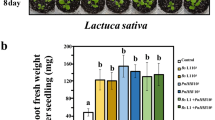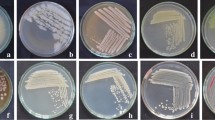Abstract
Enhanced production of the antibiotic iturin A by Bacillus subtilis RB14-CS reached 4.4 g L−1 in SM medium containing soybean meal and maltose, which was 16-fold and 2.2-fold higher than that in original and modified number 3S media, respectively. When various volumes of RB14-CS cultures grown in SM medium were applied to pot tests of tomato damping-off caused by Rhizoctonia solani, damping-off was dose-dependently suppressed by the cultures. Suppression by SM-grown cultures was significantly more effective than that by cultures grown in original or modified number 3S media. The iturin A concentrations in soil decreased to undetectable levels after 17 days of cultivation in pot tests, indicating that iturin A has a low persistence in soil.


Similar content being viewed by others
References
Akpa E, Jacques P, Wathelet B, Paquot M, Fucks R, Budzikiewicz H, Thonart P (2001) Influence of culture conditions on lipopeptide production by Bacillus subtilis. Appl Biochem Biotechnol 91:551–561
Asaka O, Shoda M (1996) Biocontrol of Rhizoctonia solani damping-off of tomato with Bacillus subtilis RB14. Appl Environ Microbiol 62:4081–4085
Carrol H, Moënne-Loccoz Y, Dowling DN, O’gara F (1995) Mutational disruption of the biosynthesis genes coding for the antifungal metabolite 2,4-diacetylphloroglucinol does not influence the ecological fitness of Pseudomonas fluorescens F113 in the rhizosphere of sugar beets. Appl Environ Microbiol 61:3002–3007
Cook RJ (1990) Twenty-five years of progress towards biological control. In: Hornby D (ed) Biological control of soil-borne plant pathogens. CAB International, Wallingford, pp 1–14
Gutterson N (1990) Microbial fungicides: recent approaches to elucidating mechanisms. Crit Rev Biotechnol 10:69–91
Haas D, Defago G (2005) Biological control of soil-borne pathogens by fluorescent pseudomonads. Nat Rev Microbiol 3:307–319
Hiraoka H, Ano T, Shoda M (1992a) Molecular cloning of a gene responsible for the biosynthesis of the lipopeptide antibiotics iturin and surfactin. J Ferment Bioeng 74:323–326
Hiraoka H, Asaka O, Ano T, Shoda M (1992b) Characteristics of Bacillus subtilis RB14, coproducer of peptide antibiotics iturin A and surfactin. J Gen Appl Microbiol 38:635–640
Huang CC, Ano T, Shoda M (1993) Nucleotide sequence and characteristics of the gene, lpa-14, responsible for biosynthesis of the lipopeptide antibiotics iturin A and surfactin from Bacillus subtilis RB14. J Ferment Bioeng 76:445–450
Katayama A, Hirai M, Shoda M, Kubota H (1986) Factors affecting the stabilization period of sewage sludge in soil with reference to the gel chromatographic pattern. Soil Sci Plant Nutr 32:383–395
Kondoh M, Hirai M, Shoda M (2001) Integrated biological and chemical control of damping-off caused by Rhizoctonia solani with Bacillus subtilis RB14-C and Flutolanil. J Biosci Bioeng 91:173–177
Kraus J, Loper JE (1995) Characterization of a genomic region required for production of the antibiotics pyoluteorin by the biological control agent Pseudomonas fluorescens Pf-5. Appl Environ Microbiol 61:849–854
Krebs B, Höding B, Kübart SM, Workie A, Junge H, Schmiedeknecht G, Groach P, Bochow H, Heves M (1998) Use of Bacillus subtilis as biocontrol agent. 1. Activities and characterization of Bacillus subtilis strains. J Plant Dis Prot 105:181–197
Leclere V, Bechet M, Adam A, Guez JS, Wathelet B, Ongena M, Thonart P, Gancel F, Chollet-Imbert M, Jacques P (2005) Mycosubtilin overproduction by Bacillus subtilis BBG100 enhances the organism’s antagonistic and biocontrol activities. Appl Environ Microbiol 71:4577–4584
Leifert C, Li H, Chidburee S, Hampson S, Workman S, Sigee D, Epton HA, Harbour A (1995) Antibiotic production and biocontrol activity by Bacillus subtilis CL27 and Bacillus pumilus CL45. J Appl Bacteriol 78:97–108
Maget-Dana R, Peypoux F (1994) Iturins, a special class of pore-forming lipopeptides: biological and physicochemical properties. Toxicology 87:151–174
McCarter SM (1991) Rhizoctonia diseases. In: Jones JB, Jones JP, Stall RE, Zitter TA (eds) Compendium of tomato diseases. APS Press, St. Paul, pp 21–22
Ohno A, Ano T, Shoda M (1993) Production of antifungal peptide antibiotics, iturin by Bacillus subtilis NB22 in a solid state fermentation. J Ferment Bioeng 75:23–27
Ongena M, Duby F, Jourdan E, Beaudry T, Jadin V, Dommes J, Thonart P (2005) Bacillus subtilis M4 decreases plant susceptibility towards fungal pathogens by increasing host resistance associated with differential gene expression. Appl Microbiol Biotechnol 67:692–698
Phae CG, Shoda M, Kubota H (1990) Suppressive effect of Bacillus subtilis and its products on phytopathogenic microorganisms. J Ferment Bioeng 69:1–7
Phae CG, Shoda M, Kita N, Nakano M, Ushiyama K (1992) Biological control of crown and root rot and bacterial wilt of tomato by Bacillus subtilis. NB22 Ann Phytopathol Soc Jpn 58:329–339
Reddy MS, Rahe JE (1989) Growth effects associated with seed bacterization not correlated with populations of Bacillus subtilis inoculant in onion seedling rhizospheres. Soil Biol Biochem 21:373–378
Ryder MH, Yan Z, Terrace TE, Rovira AD, Tang W, Correll RL (1999) Use of Bacillus strains isolated in China to suppress take-all and rhizoctonia root rot, and promote seedling growth of glasshouse-grown wheat in Australian soils. Soil Biol Biochem 31:19–29
Safiyazov JS, Mannanov RN, Sattarova RK (1995) The use of bacterial antagonists for the control of cotton diseases. Field Crop Res 43:51–54
Sailaja PR, Podile AR, Reddanna P (1997) Biocontrol strain of Bacillus subtilis AF 1 rapidly induces lipoxygenase in groundnut (Arachis Hypogaea L.) compared to crown root pathogen Aspergillus niger. Eur J Plant Pathol 104:125–132
Shoda M (2000) Bacterial control of plant diseases. J Biosci Bioeng 89:515–521
Stein T (2005) Bacillus subtilis antibiotics: structure, syntheses and specific functions. Mol Microbiol 56:845–857
Szczech M, Shoda M (2004) Biocontrol of Rhizoctonia damping-off of tomato by Bacillus subtilis combined with Burkholderia cepacia. J Phytopathol 152:549–556
Tokuda Y, Ano T, Shoda M (1995) Survival of Bacillus subtilis NB22 and its transformant in soil. Appl Soil Ecol 2:85–94
Touré Y, Ongena M, Jacques P, Guiro A, Thonart P (2004) Role of lipopeptides produced by Bacillus subtilis GA1 in the reduction of grey mould disease caused by Botrytis cinerea on apple. J Appl Microbiol 96:1151–1160
Tsuge K, Ano T, Hirai M, Nakamura Y, Shoda M (1999) The genes, degQ, pps and lpa-8 (sfp) are responsible for conversion of Bacillus subtilis strain 168 to plipastatin production. Antimicrob Agents Chemother 43:2183–2192
Tsuge K, Akiyama T, Shoda M (2001) Cloning, sequencing and characterization of iturin A operon. J Bacteriol 183:6265–6273
Ushiyama K, Nishimura J, Aono N (1987) Damping-off of feather cockscomb (Celosia argentea L. var. cristata O. Kuntze) caused by Rhizoctonia solani Kuhn. Bull Kanagawa Hortic Exp Stn 34:33–37
Walsh UF, Morrissey JP, O’Gara F (2001) Pseudomonas for biocontrol of phytopathogens: from functional genomics to commercial exploitation. Curr Opin Biotechnol 12:289–295
Weller DM (1988) Biological control of soil-borne plant pathogens in the rhizosphere with bacteria. Annu Rev Phytopathol 26:379–407
Zheng XY, Sinclair JB (2000) The effects of traits of Bacillus megaterium on seed and root colonization and their correlation with the suppression of Rhizoctonia root rot of soybean. BioControl 45:223–243
Author information
Authors and Affiliations
Corresponding author
Rights and permissions
About this article
Cite this article
Mizumoto, S., Hirai, M. & Shoda, M. Enhanced iturin A production by Bacillus subtilis and its effect on suppression of the plant pathogen Rhizoctonia solani . Appl Microbiol Biotechnol 75, 1267–1274 (2007). https://doi.org/10.1007/s00253-007-0973-1
Received:
Revised:
Accepted:
Published:
Issue Date:
DOI: https://doi.org/10.1007/s00253-007-0973-1




